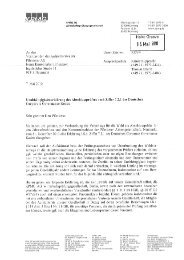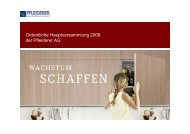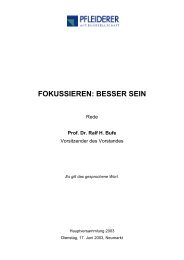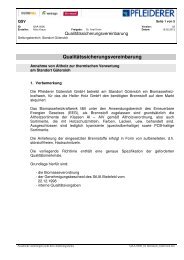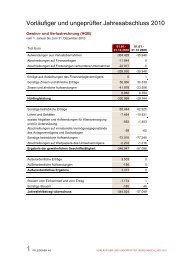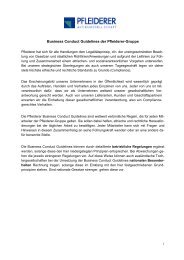PDF, 3.2 MB - Pfleiderer AG
PDF, 3.2 MB - Pfleiderer AG
PDF, 3.2 MB - Pfleiderer AG
Create successful ePaper yourself
Turn your PDF publications into a flip-book with our unique Google optimized e-Paper software.
1. Leases<br />
2. Valuation of<br />
inventories<br />
HGB does not stipulate explicitly how lease transactions should be treated. German companies<br />
therefore generally fall back on the leasing decrees issued by the tax authorities when deciding<br />
on how to account for leases. Applying tax criteria to lease agreements generally has the effect<br />
that leased assets are recognized in the lessor’s balance sheet.<br />
Comprehensive rules (especially SFAS 13) exist under US-GAAP on accounting for lease transactions.<br />
As a matter of principle, a distinction is drawn between capital leases and operating leases,<br />
depending on which party bears the significant rewards and risks from the use of the leased<br />
assets and can thus be regarded as their economic owner. The lessee must capitalize the leased<br />
asset if he is regarded as the economic owner, and the lessor must capitalize it in the event of<br />
an operating lease.<br />
Under HGB, inventories are valued as of the balance sheet date, in accordance with the strict<br />
principle of the lowest value, at the lower of cost and market or a lower fair value. The fair value<br />
of raw materials, consumables and supplies is generally based on the replacement values on the<br />
procurement market and, for work in process and finished goods, by the inverse method starting<br />
off from the net proceeds of sale on the sales market.<br />
Under US-GAAP, inventories are valued at the lower of cost or market on the basis of individual<br />
values or applying the weighted average method. The FIFO method (first in-first out) is also applied<br />
in justified individual cases. Market value is based as a matter of principle on the replacement<br />
value. The ceiling for determination of market value is the estimated selling price in the ordinary<br />
course of business less the estimated costs of completion and the expected costs necessary to<br />
make the sale (net realizable value). The floor for determination of market value is net realizable<br />
value less a normal profit margin.<br />
The production costs also include, in addition to direct material and production costs, an appropriate<br />
share of the material and production overheads caused by the production process.<br />
All foreseeable risks in the inventories that have resulted from diminished usability or obsolescence<br />
were reflected by appropriate write-downs. Markdowns were recorded for slow-moving<br />
items.<br />
111<br />
FINANCIAL STATEMENTS/NOTES PFLEIDERER GROUP





